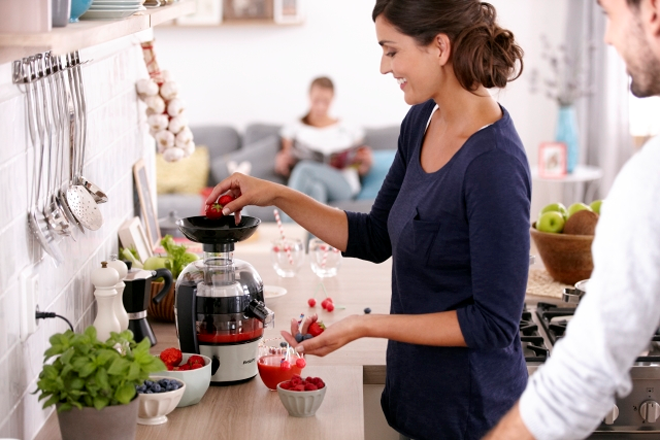SIMONE BOULANGERIE explores the world of juicing, fresh juicers, juicing machines and the health benefits of drinking juice …
“… many fruit juices contain potassium which helps balance sodium in the diet and lowers blood pressure …”
Fresh Juicers Facts #1: Water Water Everywhere
Fruits and vegetables provide a substance which is absolutely essential for good health – water. More than 65% of the cells in the human body are made of water, and in some tissues, for example the brain, the cells can be made up of as much as 80% water. Water is absolutely essential for good health, yet most people don’t consume enough water each day. Plus, many of the fluids we do drink: coffee, tea, soft drinks, alcoholic beverages and artificially-flavoured drinks contain substances that require extra water for your body to eliminate. Fruit and vegie juices are free of these unneeded substances and are full of pure, clean water.
Fresh Juicers Facts #2: Juicing Sets the Good Stuff Free
Since juicing removes the indigestible fibre, nutrients are available to the body in much larger quantities than if the piece of fruit or vegetable was eaten whole. Because many of the nutrients are trapped in the fibre, when you eat a raw carrot, you’re only able to assimilate about 1% of the available beta carotene. When a carrot is juiced, removing the fibre, nearly 100% of the beta carotene can be assimilated.
Fresh Juicers Facts #3: Give Us This Day
The problem is that most of us don’t eat enough fruits and vegetables to reap the benefits they offer. For example, although the American National Cancer Institute recommends five servings of vegetables and three of fruits each day, the truth is this: The average American eats only one-and-a-half servings of vegetables and, on average, no fruit on any given day….more to follow …
Health Benefits of Fresh Juicers
Eating fruits and vegetables helps keep you healthy and protects against disease, but it’s not always easy to consume as much produce as experts advise. Fortunately, juices can be a convenient way to squeeze in extra servings. Six ounces — just 3/4 cup of juice — counts as one serving of a fruit or vegetable.
” Fruit and vegetable juices are excellent natural sources of vitamins and minerals and, in moderation, can be part of a healthy diet,” says Barry W. Ritz, PhD, a nutritional immunology researcher at Drexel University in Pennsylvania. “Compounds found in fruit and vegetable juices appear to have widespread positive effects on health.”
And the variety of juices available today helps expand our palates, too. Besides longtime favorites such as orange, grape, and apple juice, “now we have exotic juices made from things like pomegranate or blueberry or lychee,” Ritz says. But does juice provide the same nutritional benefits as the whole food from which it is extracted? Does it matter whether juice is fresh squeezed, bottled or canned, frozen, made from concentrate, or found in a juice cocktail or drink?
What are the nutritional benefits of fresh juicers?
Juice provides many – but not all – of the benefits you’d obtain from eating whole fruit or vegetables. Nutrients in fruit juices vary, depending on what was in the fruit before it was pressed and what, if anything, has been added to the juice.
Many fruit juices contain potassium, which helps balance sodium in the diet and lowers blood pressure. Vitamin C in some fruit juices helps heal cuts and bruises, prevents infection, and aids in the absorption of iron (helping our bodies use the iron we get from foods), and vitamin A benefits eye and skin health. Carbohydrates from natural sugars in 100 percent juice provide energy, and the water content in juice helps meet fluid requirements. Fruits and vegetables have beneficial antioxidants (nutrients such as polyphenols, quercetin, anthocyanins) — thousands have been identified so far — and 100 percent juices contain an array of these compounds, which aren’t listed in the Nutrition Facts panel of the product.
On the other hand, a key loss in processing fruit to juice is fiber, which, in addition to controlling cholesterol levels and aiding digestion, also helps slow consumption and increases satiety. “It takes longer to consume an apple than to drink the equivalent amount of apple juice,” Ritz explains. You miss out on certain antioxidants, too, says University of Arkansas food scientist Luke Howard, PhD. When fruit is pressed to extract juice, some antioxidants are left behind when fruit skins and seeds are removed. Also, vegetable juices may be high in sodium due to added salt, which is sometimes used as a preservative and flavor enhancer; look for versions with less sodium.
Why does juice have more calories than fruit?
” The increase in calories is due to the increased percentage of sugar as a proportion of the juice,” Ritz says. “Even if you have 100 percent juice with no added sugar, by removing fiber and all the different components of the fruit that do not make it into the juice, you’re left with a higher concentration of sugar.” More sugar means more calories. One serving (1/2 cup) of grapes contains 31 calories — a fraction of the 116 calories found in a serving (6 ounces) of grape juice. What’s more, the average individual juice bottle size is 16 ounces. One 16-ounce bottle yields 2.6 servings and 308 calories total.
What is the difference between “100 percent juice” and “juice drink” or “juice cocktail”?
The difference is determined by the amount of juice the drink contains. Only 100 percent juice can be labeled “juice.” (Mixed juices can be labeled “100 percent juice” if each of the juices added to the mixture is, itself, a 100 percent juice, Howard says.) Anything less than 100 percent juice must be labeled under another name. Juice “drink,” “beverage,” “cocktail,” “punch,” “blend,” and “sparkler” products might contain as little as 10 percent or as much as 99 percent juice. The rest is water or added sweeteners. Check the label to find out how much juice such products contain. The ingredients must be listed on the label in order of volume. The lower a juice appears on the ingredients list, the less there is of it in the drink.
What does “from concentrate” mean and how does it affect the juice’s nutrient profile?
Juice made from concentrate is the same as the original juice. The only thing missing is most of the water. Extracting water reduces juice volume and weight, making it easier to ship, Howard says. When water is added back to the concentrate, the product is labeled “reconstituted” or “made from concentrate” and has the same nutrition profile as the original juice. “As long as there has been no change in the juice other than water being removed and put back in, the label can identify the beverage as ‘100 percent juice from concentrate,'” says Jennifer Seymour, PhD, an epidemiologist in the Division of Nutrition, Physical Activity, and Obesity at the Centers for Disease Control and Prevention in Atlanta.
Why is apple, pear, or grape juice often the first ingredient in juices that aren’t apple, pear, or grape?
Naturally sweet juices such as apple, pear, and grape help make especially tart or acidic juices more palatable. “It’s a way of adding sugar without having to put ‘sweetened with added sugar’ or other sweeteners on the label,” says Adam Drewnowski, PhD, director of the Center for Public Health and Nutrition at the University of Washington in Seattle. For example, unadulterated cranberry juice is extremely tart and must be sweetened. What makes it tart? Antioxidants. “They are, almost without exception, bitter, acrid, or astringent,” Drewnowski says. “The more antioxidants you have in a product, the more bitter it is going to be.” The reason: Antioxidants are meant to protect the plant by making it taste bad to predators.
Does fresh-squeezed juice offer any nutritional advantages?
If you’re fresh-squeezing juice at home or buying in-store fresh-squeezed juice, it may offer a slight nutritional edge, says Sue Taylor, MS, RD, director of nutrition communications for the Juice Products Association based in Washington, D.C. But, she adds, in the big picture any differences would not be significant when juice is consumed as part of a well-balanced diet.
Are fortified juices helpful?
Fruit juice is sometimes enhanced with nutrients intended to provide health benefits because juice is convenient, has good flavor, and is inherently associated with good health, Ritz says. Juices may be fortified with extra vitamins (such as vitamin C), minerals (such as calcium), cholesterol-lowering sterols, and, increasingly, omega-3 fatty acids. Such juices may be a good idea if they’re fortified with nutrients you don’t obtain enough of in your normal diet. “For people who are lactose-intolerant, calcium-fortified orange juice can be an important source of calcium,” Seymour says.
Could fresh juicers protect against specific diseases?
“Historically, fruit and vegetable juices have been tied to a number of specific health claims,” Ritz says. “For example, consider the long-standing association between cranberry juice and urinary tract health. Although data is limited, daily consumption of cranberry juice does appear to help prevent recurrent urinary tract infections in some women.” Studies also suggest that pomegranate juice may help lower total cholesterol and reduce systolic blood pressure.
Must I give up juice if I’m taking a prescription medication to lower my cholesterol?
“Grapefruit juice can interfere with the metabolism of a number of prescription drugs, including certain cholesterol-lowering statins, antidepressants, and even Viagra,” Ritz says. Grapefruit contains a natural substance that inhibits the liver’s ability to metabolize (break down so the body can utilize) certain drugs. That can result in increased levels of the drug in the body, and with that increase, an elevated risk of harmful side effects.
Also, cranberry juice may interfere with warfarin (Coumadin), a blood-thinning medication. Talk to your physician or pharmacist about the potential for interactions between any medication you’re taking and the juices you drink.
There are a number of suppliers where you can get the Compact Fresh Juicer for a special introductory price of $299 inc gst (RRP$399).














